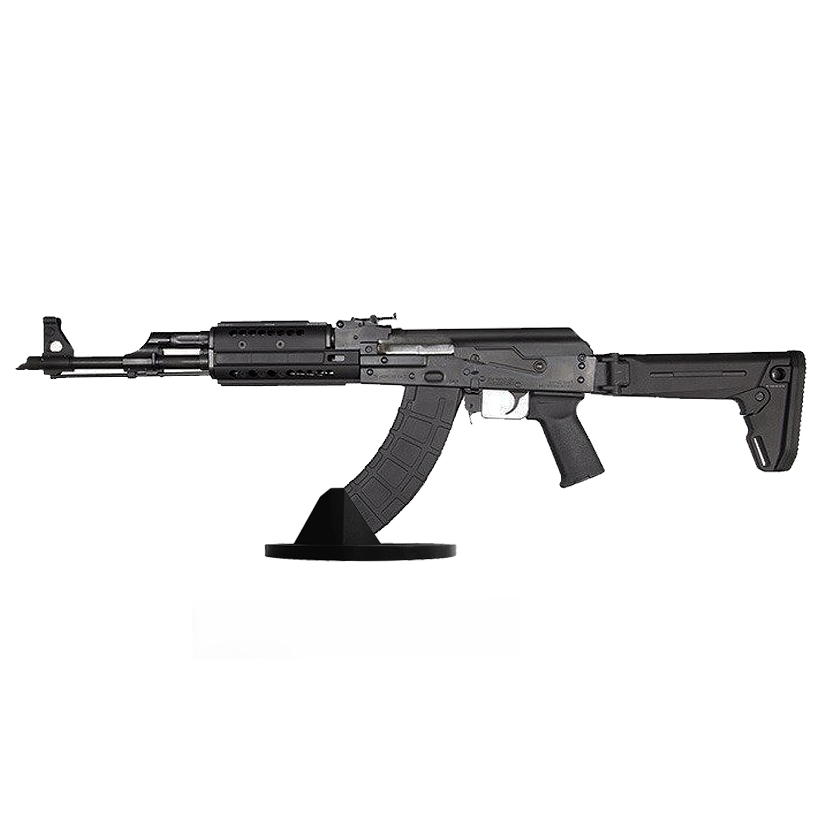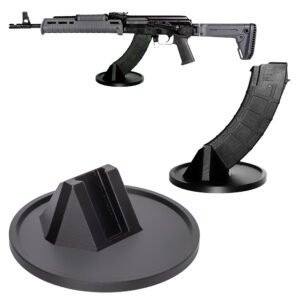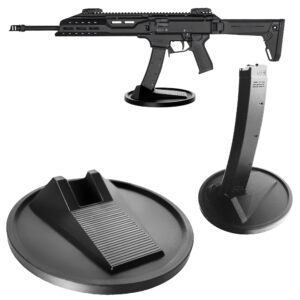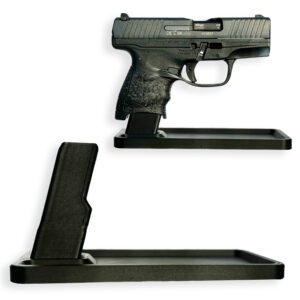
Categories:
The AK-47, one of the most widely recognized and used guns in the world, is renowned for its reliability, simplicity, and effectiveness. Central to its operation is its bolt mechanism, a component that plays a pivotal role in the weapon’s functionality. The bolt mechanism is integral to the processes of chambering a cartridge, ensuring its secure placement, and allowing for the gun to be fired effectively.
Understanding the workings of the AK-47’s bolt mechanism offers valuable insights into why this particular rifle has sustained its reputation and widespread use since its creation. When the trigger of an AK-47 is pulled, a series of mechanical events are set into motion, with the bolt mechanism at the heart of these operations. The firing sequence begins with the release of the hammer, which strikes the firing pin.
This impact detonates the primer of the chambered cartridge, igniting the gunpowder within and creating a high-pressure gas. This gas propels the bullet down the barrel while simultaneously exerting force backward against the bolt carrier. The backward motion of the bolt carrier, driven by this gas pressure combined with the action spring, is crucial for the semi-automatic operation of the rifle.
As the bolt carrier retracts, the bolt itself is rotated and unlocked from the breech. This motion extracts and ejects the spent cartridge case through the ejection port. Following the ejection, the bolt carrier, propelled forward again by the recoil spring, enacts the loading phase by picking up a new cartridge from the magazine and guiding it into the chamber. During this process, the bolt rotates once more to lock securely into place against the breech, ensuring the chamber is sealed and ready for the next shot.
This locking mechanism is vital as it withstands the immense pressure generated when a round is fired. The AK-47’s bolt mechanism, therefore, exemplifies a seamless blend of mechanical precision and rugged simplicity. Designed to function reliably under a variety of conditions, the bolt mechanism ensures that the rifle can continue to operate effectively even in adverse environments. This robustness is one of the key features that have made the AK-47 an enduring presence in global military and civilian markets.
The AK-47 bolt is a critical component of this iconic rifle, playing a fundamental role in its reliable performance. It is intricately designed to facilitate the loading, chambering, firing, and extraction of cartridges with precision and durability. Composed of several key elements, each part of the bolt works harmoniously to ensure the rifle operates smoothly under various conditions.
At the core of the bolt’s functionality is the bolt head, which is responsible for engaging the cartridge during the loading process. The bolt head contains locking lugs that match the locking recesses in the barrel extension, ensuring the bolt securely locks into place when the rifle is ready to fire. This secure locking mechanism is paramount for maintaining the rifle’s integrity during the high-pressure event of firing a cartridge.
The extractor is another crucial element of the AK-47 bolt. It grabs the rim of the cartridge case and holds it firmly in place against the bolt face as the rifle cycles. When the cartridge is fired, and the bolt moves to the rear, the extractor pulls the spent cartridge case out of the chamber. This action is synchronized with the ejector, a fixed protrusion within the receiver, which strikes the rear of the spent case and expels it from the ejection port.
Part of the bolt also includes the firing pin, which is activated by the hammer to strike the primer of the cartridge and initiate the firing sequence. The firing pin must be resilient and finely tuned to strike with enough force to ignite the primer consistently while surviving the rapid and repetitive forces experienced during the rifle’s operation.
Lastly, the camming mechanism in the bolt carrier works in unison with the bolt itself. It ensures that the bolt rotates and engages or disengages the locking lugs effectively during the cycling process. This rotation and engagement sequence is what allows the rifle to reload and prepare for subsequent shots.
Each of these components is crafted with durability and precision in mind, reflecting the AK-47’s reputation for reliability even in harsh environments. Together, they make the AK-47’s bolt an exemplary piece of engineering, central to the weapon’s legendary performance on battlefields around the world.
The bolt of an AK-47 plays an essential role in the process of loading and firing the weapon by engaging the cartridge. Its intricate mechanics ensure the precise alignment of the cartridge within the chamber, contributing significantly to the gun’s reliability and functionality. As the shooter pulls the charging handle, the bolt is drawn back, which simultaneously compresses the recoil spring in preparation for firing.
Upon releasing the charging handle, the compressed recoil spring propels the bolt forward with considerable force.
As the bolt moves ahead, it picks up a cartridge from the magazine and guides it into the chamber. This phase is crucial because any misalignment can lead to a malfunction known as a misfeed, where the cartridge fails to enter the chamber correctly. The bolt’s engineered grooves and guides are designed to facilitate this smooth transfer, reducing the chances of such malfunctions.
Additionally, the bolt’s extractor comes into play here, gripping the rim of the cartridge firmly to ensure it remains in the correct position for firing.
Beyond mere placement, the bolt’s engagement with the cartridge is vital for securing it in place, ready for the firing sequence. When the bolt is fully closed and locked into position, the firing pin, which is integrated within the bolt assembly, aligns perfectly with the primer of the engaged cartridge. This precise alignment is indispensable for the detonation of the primer upon the trigger pull, which in turn ignites the gunpowder within the cartridge, propelling the bullet out of the barrel.
The bolt’s locking mechanism further underscores its role in safe and effective gun operation. When the bolt locks into the barrel extension, it ensures the high pressures generated during firing are contained within the chamber, maintaining structural integrity and preventing catastrophic failures. This locking action also absorbs much of the recoil energy, making subsequent shots more controllable for the shooter.
Overall, the bolt’s role in engaging the cartridge within an AK-47 is multi-faceted, involving precise mechanical actions that ensure reliable feeding, secure chambering, and safe, consistent firing. Each component of the bolt interacts seamlessly to uphold the gun’s legendary reliability in a variety of conditions, making the bolt one of the most critical elements in the AK-47’s operation.
The AK-47, a widely recognized and durable assault rifle, exemplifies the marriage of mechanical precision and robust design. Central to its operation is the process by which the bolt engages the cartridge, ensuring both the loading and eventual firing of the weapon. Understanding this process sheds light on the effective and reliable nature of the AK-47’s engineering. When a shooter pulls the charging handle, the bolt is retracted backwards, compressing the recoil spring located within the receiver.
This rearward motion of the bolt carrier group clears the chamber of any spent cartridge cases and readies the weapon to receive a new round. The extractor claw, attached to the bolt, holds onto the rim of a fired case, pulling it out of the chamber. Upon reaching the apex of its rearward travel, the next round in the magazine is positioned by the pressure of the magazine spring, ready to be pushed into the chamber.
As the shooter releases the charging handle, the recoiled spring is released, propelling the bolt carrier group back forward with significant force. This forward motion of the bolt carrier group initiates a sequence of actions crucial for the loading process. The bolt, driven by the bolt carrier, engages the uppermost cartridge in the magazine. The bullet nose of the cartridge ramps up into the chamber aligned by the feed lips of the magazine.
During this motion, the bolt face presses against the rear of the cartridge, guiding it out of the magazine and into the firing chamber. Precision engineering ensures that the cartridge is smoothly and securely chambered without misalignment or jamming. Once fully encased within the chamber, the bolt rotates and locks into place. This rotary motion is achieved through interaction between camming surfaces on the bolt and carrier, causing the bolt to twist and align its locking lugs with corresponding recesses in the barrel extension.
This lock-up is vital, as it ensures that the cartridge is held firmly in place, ready to be struck by the firing pin when the trigger is pulled.
When the cartridge is loaded into the chamber of an AK-47, the bolt plays a critical role in ensuring that the gun is ready to be fired safely and effectively. The process begins as the bolt is driven forward by the recoil spring, which is compressed during the previous firing cycle. As the bolt moves forward, it picks up a new cartridge from the magazine and pushes it into the chamber.
This progression is smooth and forceful, designed to seat the cartridge securely.
Once the cartridge is fully seated in the chamber, the bolt itself must be locked in place to withstand the high pressure produced by the gunpowder ignition during firing. This locking mechanism is achieved through the bolt carrier system which incorporates a rotating bolt. As the bolt carrier group advances, a cam path within the bolt carrier guides a cam pin, which in turn causes the bolt to rotate.
This rotation is crucial, as it aligns the bolt’s locking lugs with the matching recesses in the receiver.
When these lugs engage firmly within their recesses, the bolt is effectively locked, securing the cartridge case and ensuring the breech is closed. This locked position guarantees that when the firing pin strikes the primer of the cartridge, the resulting explosion and high-pressure gases are contained within the chamber. Containment is vital; it directs the force of the explosion forward to propel the bullet through the barrel while preventing any backward release of pressure which could damage the gun or harm the operator.
This locking mechanism is both mechanically robust and reliable, allowing the AK-47 to maintain its reputation for enduring adverse conditions such as dirt, moisture, and grime without losing functionality. The secure engagement of the bolt and its proper alignment through careful engineering ensures that each shot is fired with precision, making the AK-47 not only powerful but also consistent in its performance.
Through this intricate interplay of components, the integrity of each firing sequence is maintained, ultimately making the AK-47 one of the most dependable guns in the field.
The AK-47, a hallmark of simplicity and reliability in gun design, showcases intricate mechanics within its bolt operation during discharge. This precision engineering begins when the trigger is pulled, initiating a cascade of events that culminates in firing a round. Central to this sequence is the bolt, a vital component that engages the cartridge and facilitates both loading and firing processes with seamless efficiency.
Upon depressing the trigger, the hammer is released, striking the firing pin. This impact ignites the primer of the chambered cartridge, resulting in a controlled explosion within the cartridge’s casing. The generated gases exert high pressure, propelling the bullet down the barrel and out of the gun. Simultaneously, these expanding gases drive the bolt carrier group backward.
As the bolt carrier recoils, the bolt itself rotates slightly due to the interaction with the camming surfaces within the receiver. This rotational motion of the bolt disengages its locking lugs from the corresponding recesses in the barrel extension, freeing the bolt to move rearward. During this rearward travel, the spent cartridge case is extracted from the chamber and ejected out of the gun through the ejection port.
At the peak of its rearward journey, the bolt carrier group compresses the recoil spring, storing kinetic energy that will soon be pivotal. The momentum halts momentarily before the recoil spring pushes the bolt carrier group forward, driving fresh energy into the cyclical process. As the bolt carrier advances, it strips a new cartridge from the magazine, guiding it into the chamber.
Crucially, the bolt once again engages in its locking sequence during this forward movement. The camming surfaces force the bolt into a slight rotational motion, ensuring the locking lugs align perfectly with their recesses. This secure engagement is fundamental, providing the necessary supportive strength to withstand the pressures of firing. The gun is now primed and ready to discharge another round upon the next trigger pull.
The AK-47’s bolt operation is a remarkable demonstration of mechanical ingenuity, balancing power, precision, and reliability. Through every discharge cycle, it exemplifies how meticulous design can yield a gun capable of enduring harsh conditions while maintaining consistent performance.
Maintenance and troubleshooting of the AK-47 bolt mechanism are essential for ensuring the reliable operation of the gun. Maintaining the bolt starts with regular cleaning, focusing on removing carbon build-up and other debris that can impair its function. Field-stripping the weapon is the initial step, requiring the removal of the dust cover, recoil spring, and bolt carrier group. Once the bolt and bolt carrier are accessible, they should be thoroughly cleaned using proper solvents and brushes, ensuring that all carbon fouling, dirt, or unburnt powder residue is eliminated.
Lubrication is equally important; a light coat of high-quality gun oil should be applied to all moving parts. However, it’s crucial not to over-lubricate as excess oil can attract dirt, leading to further malfunctions.
Inspecting the bolt carrier and associated components regularly is vital for catching potential issues early. Key areas to focus on include the bolt lugs, extractor claw, and firing pin. Check for signs of wear or deformation, as these can greatly impact the function of the bolt. The extractor spring should also be inspected and replaced if it appears weakened or damaged, as it plays a critical role in the reliable ejection of spent cartridges.
When troubleshooting malfunctions, understanding the common issues affecting the bolt mechanism can save time. Failure to feed, extract, or eject are common problems that typically result from dirty or worn components. For a failure to feed, ensure the bolt face and chamber are clean, and verify that the magazine is functioning correctly. Extraction failures can often be traced back to the extractor claw or spring; these should be cleaned or replaced as necessary.
Ejection issues might be resolved by checking the ejector on the bolt carrier for damage or wear.
Ensuring that the bolt mechanism is in good condition is essential for the reliable function of the AK-47. Prompt attention to wear, cleanliness, and lubrication can extend the life of the gun and maintain its robust performance. Regular inspection, coupled with timely maintenance and repairs, will keep the gun operational and reliable, ready for use when needed.








Colt
Colt M4 Carbine
Colt LE6920
Colt AR-15 A4
Daniel Defense
DDM4 V7
DDM4 V9
DDM4 V11
DDM4 ISR (Integrally Suppressed Rifle)
Smith & Wesson (S&W)
M&P15 Sport II
M&P15 Tactical
M&P15T
Bravo Company Manufacturing (BCM)
BCM Recce-16
BCM Recce-14
BCM MCMR Series
Aero Precision
M4E1 Series
AC-15
AR15 Pistol (Various Configurations)
Ruger
Ruger AR-556
Ruger SR-556
Ruger AR-556 MPR (Multi-Purpose Rifle)
Springfield Armory
Saint Victor
Saint Edge
Saint AR-15
PSA (Palmetto State Armory)
PSA PA-15
PSA AR-V
PSA Jakl (AR Pistol)
FN America
FN 15 Tactical Carbine
FN 15 Patrol
FN 15 DMR
Wilson Combat
Recon Tactical
Super Sniper
Protector Carbine
SIG Sauer
SIG M400 Tread
SIG M400 Elite
SIG M400 SDI
LWRC International
IC DI (Direct Impingement)
IC SPR
IC A5
Bushmaster Guns
XM-15 QRC
Bushmaster MOE
XM-15 Patrolman
Rock River Arms
LAR-15 Entry Tactical
LAR-15 Predator
LAR-15 Elite Comp
Stag Arms
Stag 15 Tactical
Stag 15L (Left-Handed Models)
Stag 15 Valkyrie
Noveske Rifleworks
Noveske Gen 4 N4
Noveske Space Invader (AR Pistol)
Noveske Recon
Anderson Manufacturing
AM-15 Optic Ready
AM-15 M4 Carbine
AM-15 Precision Rifle
Adams Arms
AA-15 Piston Rifle
P2 AARS (Adams Arms Rifle Series)
Black Rain Ordnance
SPEC15 Series
BRO Predator
Fallout 15
Diamondback Guns
DB15 Series
DB15CCMLB
DB15EB
Del-Ton Inc.
DTI-15
Del-Ton Echo 316H
Sierra 316M
Windham Weaponry
Windham SRC
Windham VEX-SS
Windham RMCS-4 (Caliber Conversion System)
Christensen Arms
CA-15 G2
CA-15 Recon
CA-15 Titanium Edition
Patriot Ordnance Factory (POF-USA)
Renegade Plus
P415 Edge
Revolution DI
LaRue Tactical
PredatAR
OBR (Optimized Battle Rifle)
LaRue Stealth 2.0
Battle Arms Development
Workhorse Patrol Carbine
BAD556-LW (Lightweight)
Authority Elite Rifle
Faxon Guns
Ascent AR-15
FX-19 (AR Pistol)
Streamline Ultralight Series
KE Arms
KE-15 SLT (Super Lightweight Tactical)
KE-15 Scout Carbine
Primary Weapons Systems (PWS)
MK1 MOD 2-M
MK116 PRO
MK107 (Piston AR Pistol)
ZEV Technologies
ZEV Core Elite Rifle
ZEV AR15 Billet Rifles
Franklin Armory
BFSIII AR-C1
Militia Model
F17-L (Chambered in .17 WSM)
Seekins Precision
SP15 DMR
NX15 Skeletonized Rifle
Havak Bravo
Aero Precision (Additional Models)
EPC-9 (Pistol Caliber ARs)
VG6 AR Rifles
Barrett Guns
REC7 DI
REC7 Gen II
CMMG
MK4 RCE
Resolute 300
Banshee (AR Pistol)
DPMS Panther Arms
Panther Oracle
Panther LR-308
H&K (Heckler & Koch)
HK MR556A1
HK416 (Military Variant)
Rock Island Armory (Armscor)
VR-80 Tactical AR (Shotgun AR Platform)
Troy Industries
Troy SPC-A3
Troy PAR (Pump Action AR)
Wilson Tactical
Tactical Recon AR
Protector Series
F1 Guns
FDR-15 Skeletonized Rifle
BDRx-15 Series
Juggernaut Tactical
JT-15
JT-10 Precision Rifle
AeroSurplus
Surplus AR-15 Rifles (Budget Models)
Thunder Tactical
AR-15 Basic Carbine
Tactical Builder Sets
Radical Guns
RF-15
Forged AR-Series
Dark Storm Industries
DS-15 Featureless Rifles
DS-10 Typhoon
DRD Tactical
Paratus
Aptus AR Rifles
Bear Creek Arsenal
BCA-15
AR Complete Upper Builds
Aero Survival Rifles (ASI)
ASR Tactical Series
Tactical Edge
WARFIGHTER Series
AR-15 Lightweight Rifles
Lone Star Armory
TX15 DMR
TX15 Carbine
HERA Arms
HERA H7
HERA AR-15 Lower Builds
IWI (Israeli Weapon Industries)
Zion-15
DRD Tactical
Tactical Modular Rifles
Quick-Takedown Rifles
V Seven Weapons
1776 Rifle
Hyperlite Rifle
Core Rifle Systems
Core15 Tac III
Core15 Patrol Rifle
Armalite (Original AR-15 Creator)
M15 Tactical
M15 A4 Carbine
DEF15 (Defensive Sporting Rifle Series)
PSA (Palmetto State Armory Additional Models)
PSAK-47 Hybrid (AR-AK Style Hybrid)
PSA Dagger (Pistol Caliber Configurations)
Odin Works
OTR-15
Odin Recon Rifle
Maxim Defense
MDX-508 PDX (Compact AR Pistol)
MDX-510 Rifle